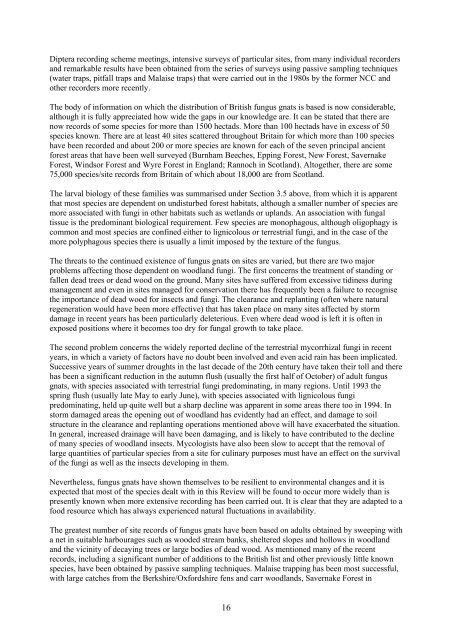Part 2: Nematocera and Aschiza not dealt with by Falk (1991) - JNCC
Part 2: Nematocera and Aschiza not dealt with by Falk (1991) - JNCC
Part 2: Nematocera and Aschiza not dealt with by Falk (1991) - JNCC
Create successful ePaper yourself
Turn your PDF publications into a flip-book with our unique Google optimized e-Paper software.
Diptera recording scheme meetings, intensive surveys of particular sites, from many individual recorders<br />
<strong>and</strong> remarkable results have been obtained from the series of surveys using passive sampling techniques<br />
(water traps, pitfall traps <strong>and</strong> Malaise traps) that were carried out in the 1980s <strong>by</strong> the former NCC <strong>and</strong><br />
other recorders more recently.<br />
The body of information on which the distribution of British fungus gnats is based is now considerable,<br />
although it is fully appreciated how wide the gaps in our knowledge are. It can be stated that there are<br />
now records of some species for more than 1500 hectads. More than 100 hectads have in excess of 50<br />
species known. There are at least 40 sites scattered throughout Britain for which more than 100 species<br />
have been recorded <strong>and</strong> about 200 or more species are known for each of the seven principal ancient<br />
forest areas that have been well surveyed (Burnham Beeches, Epping Forest, New Forest, Savernake<br />
Forest, Windsor Forest <strong>and</strong> Wyre Forest in Engl<strong>and</strong>; Rannoch in Scotl<strong>and</strong>). Altogether, there are some<br />
75,000 species/site records from Britain of which about 18,000 are from Scotl<strong>and</strong>.<br />
The larval biology of these families was summarised under Section 3.5 above, from which it is apparent<br />
that most species are dependent on undisturbed forest habitats, although a smaller number of species are<br />
more associated <strong>with</strong> fungi in other habitats such as wetl<strong>and</strong>s or upl<strong>and</strong>s. An association <strong>with</strong> fungal<br />
tissue is the predominant biological requirement. Few species are monophagous, although oligophagy is<br />
common <strong>and</strong> most species are confined either to lignicolous or terrestrial fungi, <strong>and</strong> in the case of the<br />
more polyphagous species there is usually a limit imposed <strong>by</strong> the texture of the fungus.<br />
The threats to the continued existence of fungus gnats on sites are varied, but there are two major<br />
problems affecting those dependent on woodl<strong>and</strong> fungi. The first concerns the treatment of st<strong>and</strong>ing or<br />
fallen dead trees or dead wood on the ground. Many sites have suffered from excessive tidiness during<br />
management <strong>and</strong> even in sites managed for conservation there has frequently been a failure to recognise<br />
the importance of dead wood for insects <strong>and</strong> fungi. The clearance <strong>and</strong> replanting (often where natural<br />
regeneration would have been more effective) that has taken place on many sites affected <strong>by</strong> storm<br />
damage in recent years has been particularly deleterious. Even where dead wood is left it is often in<br />
exposed positions where it becomes too dry for fungal growth to take place.<br />
The second problem concerns the widely reported decline of the terrestrial mycorrhizal fungi in recent<br />
years, in which a variety of factors have no doubt been involved <strong>and</strong> even acid rain has been implicated.<br />
Successive years of summer droughts in the last decade of the 20th century have taken their toll <strong>and</strong> there<br />
has been a significant reduction in the autumn flush (usually the first half of October) of adult fungus<br />
gnats, <strong>with</strong> species associated <strong>with</strong> terrestrial fungi predominating, in many regions. Until 1993 the<br />
spring flush (usually late May to early June), <strong>with</strong> species associated <strong>with</strong> lignicolous fungi<br />
predominating, held up quite well but a sharp decline was apparent in some areas there too in 1994. In<br />
storm damaged areas the opening out of woodl<strong>and</strong> has evidently had an effect, <strong>and</strong> damage to soil<br />
structure in the clearance <strong>and</strong> replanting operations mentioned above will have exacerbated the situation.<br />
In general, increased drainage will have been damaging, <strong>and</strong> is likely to have contributed to the decline<br />
of many species of woodl<strong>and</strong> insects. Mycologists have also been slow to accept that the removal of<br />
large quantities of particular species from a site for culinary purposes must have an effect on the survival<br />
of the fungi as well as the insects developing in them.<br />
Nevertheless, fungus gnats have shown themselves to be resilient to environmental changes <strong>and</strong> it is<br />
expected that most of the species <strong>dealt</strong> <strong>with</strong> in this Review will be found to occur more widely than is<br />
presently known when more extensive recording has been carried out. It is clear that they are adapted to a<br />
food resource which has always experienced natural fluctuations in availability.<br />
The greatest number of site records of fungus gnats have been based on adults obtained <strong>by</strong> sweeping <strong>with</strong><br />
a net in suitable harbourages such as wooded stream banks, sheltered slopes <strong>and</strong> hollows in woodl<strong>and</strong><br />
<strong>and</strong> the vicinity of decaying trees or large bodies of dead wood. As mentioned many of the recent<br />
records, including a significant number of additions to the British list <strong>and</strong> other previously little known<br />
species, have been obtained <strong>by</strong> passive sampling techniques. Malaise trapping has been most successful,<br />
<strong>with</strong> large catches from the Berkshire/Oxfordshire fens <strong>and</strong> carr woodl<strong>and</strong>s, Savernake Forest in<br />
16
















